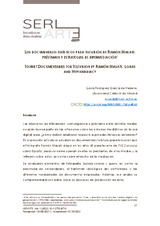Mostrar el registro sencillo del ítem
Los documentales turísticos para televisión de Ramón Masats: préstamos y estrategias de hipermediación
| dc.contributor.author | Rodríguez García de Herreros, Lucía | |
| dc.date.accessioned | 2023-01-16T11:57:56Z | |
| dc.date.available | 2023-01-16T11:57:56Z | |
| dc.date.issued | 2022 | |
| dc.identifier.issn | 2792-8713 | |
| dc.identifier.uri | http://hdl.handle.net/10396/24530 | |
| dc.description.abstract | Las relaciones de hibridación, convergencia o préstamo entre distintos medios ocupan buena parte de las reflexiones sobre los entornos mediáticos de la era digital, pero ¿cómo deben analizarse respecto a periodos históricos anteriores? En el presente artículo se estudian los documentales turísticos para televisión que el fotógrafo Ramón Masats dirigió en los años 60 para la serie de TVE Conozca usted España, para ver cómo operan en ellos los préstamos de otros medios y la reflexión sobre estos, así como sobre el hecho de la mediación. Se analizarán elementos de fotografía, banda sonora y guion, así como la presencia de celebridades, el trasfondo ideológico del comentario, y las diferentes modalidades de documental empleadas. Además, ese análisis se complementará con datos sobre los procesos de producción de estos documentales televisivos, que resultan paradigmáticos de un momento de consolidación y desarrollo que vivía TVE coincidiendo con el arranque de la segunda cadena. Se trata de información extraída de una entrevista personal con Masats. Por último, toda esta información se contextualiza en el marco del boom turístico que las instituciones aprovecharon para promover una nueva imagen de España. | es_ES |
| dc.description.abstract | Hybridization, convergence and loans between different media have motivated many reflections on the media environments of the digital age, but are they meaningful when studying previous historical periods? This article is focused on the tourist documentaries for television that Spanish photographer Ramón Masats directed in the 1960s for the TVE series Conozca usted España. The main objective is detecting how loans from other media operate in them, and how the fact of mediation is depicted. Elements of photography, soundtrack and script will be analyzed, as well as the presence of celebrities, the ideological background of the discourse, and the different modes of documentary used. In addition, this analysis is complemented with data on the production processes of these television documentaries, which are paradigmatic of the moment of consolidation and development that TVE was experiencing during the take-off of its second channel. This information was obtained from a personal interview with the author, Masats. Finally, the context will be crucial: the tourism boom that was used to promote a new image of Spain in the second half of Francoism. | es_ES |
| dc.format.mimetype | application/pdf | es_ES |
| dc.language.iso | spa | es_ES |
| dc.publisher | UCOPress | es_ES |
| dc.rights | https://creativecommons.org/licenses/by-nc-sa/4.0/ | es_ES |
| dc.source | Seriarte 1, 27-49 (2022) | es_ES |
| dc.subject | Hipermediación | es_ES |
| dc.subject | Ramón Masats | es_ES |
| dc.subject | Documental turístico | es_ES |
| dc.subject | TVE | es_ES |
| dc.subject | Boom turístico | es_ES |
| dc.subject | Turismo interno | es_ES |
| dc.subject | Hypermediacy | es_ES |
| dc.subject | Ramón Masats | es_ES |
| dc.subject | Tourist documentary | es_ES |
| dc.subject | Tourism boom | es_ES |
| dc.subject | Domestic tourism | es_ES |
| dc.title | Los documentales turísticos para televisión de Ramón Masats: préstamos y estrategias de hipermediación | es_ES |
| dc.title.alternative | Tourist documentaries for television by ramón masats: loans and hypermediacy | es_ES |
| dc.type | info:eu-repo/semantics/article | es_ES |
| dc.relation.publisherversion | https://journals.uco.es/index.php/seriarte | |
| dc.rights.accessRights | info:eu-repo/semantics/openAccess | es_ES |

